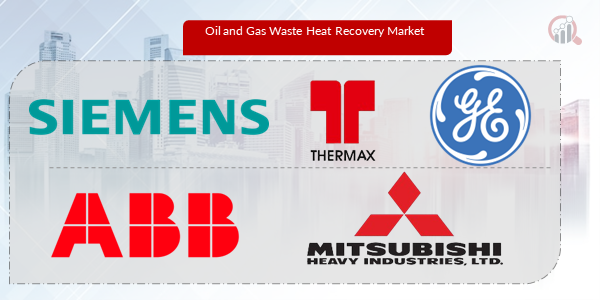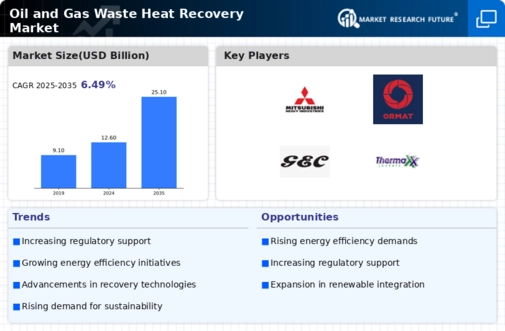Top Industry Leaders in the Oil Gas Waste Heat Recovery Market

*Disclaimer: List of key companies in no particular order
Top listed companies in the Micro Turbine industry are:
Capstone Turbine Corporation (US)
FlexEnergy, Inc. (US)
Ansaldo Energia S.p.A. (Italy)
Brayton Energy, LLC (US)
Eneftech Innovation SA (Switzerland)
Microturbine technology BV (the Netherlands)
Wilson Solarpower Corporation (US)
ICR Turbine Engine Corporation (US)
Calnetix Technologies LLC. (US)
Toyota Motor Corporation (Japan)
Bladon Jets (Isle of Man)
Competitive Landscape of Oil and Gas Waste Heat Recovery Market: Capturing the Energy Torrent
The oil and gas industry generates a substantial amount of waste heat during exploration, production, and processing. Recovering and utilizing this thermal energy presents a significant opportunity for cost savings, operational efficiency, and environmental sustainability. This has fueled the growth of the oil and gas waste heat recovery (WHR) market, attracting a diverse range of players with distinct strategies and vying for market share.
Key Player Strategies:
Technology Leaders: Global giants like Siemens, Alfa Laval, and GE Power capitalize on their established technology portfolios and extensive service networks. They focus on developing advanced heat exchangers, organic Rankine cycles (ORCs), and combined heat and power (CHP) systems, targeting large-scale oil and gas projects.
Regional Specialists: Regional players like Hangzhou Zhongjin Thermal Technology and Shanghai Electric Group Corporation cater to specific geographical markets with cost-effective and customized WHR solutions. They partner with local oil and gas companies and leverage their understanding of regional regulations and technical requirements.
Emerging Innovators: Startups like Echogen Power and Exergy are bringing disruptive technologies to the market. Echogen develops compact, modular ORC systems, making WHR feasible even for smaller applications. Exergy focuses on innovative waste heat-to-power conversion technologies, addressing challenges like low-grade heat utilization.
Market Share Analysis:
To assess the competitive landscape accurately, several factors come into play:
Technology Portfolio: Players offering a broader range of WHR technologies for various applications and heat sources hold an edge.
Project Execution Expertise: Experience in designing, installing, and commissioning WHR systems for complex oil and gas environments is crucial.
Regional Presence: Strong geographic reach and established relationships with local players in key oil and gas hubs provide a significant advantage.
Cost-Competitiveness: Offering cost-effective and scalable WHR solutions is essential for attracting budget-conscious oil and gas companies.
Sustainability Focus: Integrating WHR solutions with carbon capture and storage (CCS) technologies is becoming increasingly attractive, and players demonstrating proactive sustainability initiatives gain favor.
New and Emerging Trends:
The oil and gas WHR market is witnessing exciting developments:
Integration with Digital Technologies: Digitalization and data analytics are being leveraged to optimize WHR system performance, predict maintenance needs, and improve overall efficiency.
Focus on Low-Grade Heat Utilization: Technological advancements are enabling the recovery and utilization of low-grade waste heat, previously considered uneconomical.
Modular & Packaged Solutions: The demand for pre-engineered and modular WHR units is growing, reducing project lead times and simplifying deployment.
Circular Economy Approach: Integrating WHR with other industrial processes in a closed-loop system is gaining traction, maximizing resource utilization and minimizing waste.
Overall Competitive Scenario:
The oil and gas WHR market is characterized by intense competition, with both established players and innovative startups vying for market share. While technology leadership and project execution expertise remain crucial, cost-effectiveness, sustainability focus, and adaptability to emerging trends will be key differentiators in the years to come. Collaboration between technology providers, oil and gas companies, and government agencies will be essential to unlock the full potential of WHR and drive sustainable development in the industry.
This comprehensive overview provides a glimpse into the dynamic competitive landscape of the oil and gas WHR market. By understanding the key player strategies, market share analysis factors, and emerging trends, stakeholders can make informed decisions and capitalize on the abundant opportunities this rapidly growing market presents.
Latest Company Updates:
Capstone Turbine Corporation (US):
- Announced the release of its C65 model, offering higher efficiency and lower emissions (June 2023, Source: Capstone website).
FlexEnergy, Inc. (US):
- Launched its new M50 and M75 microturbine models with improved performance and reduced noise levels (September 2023, Source: FlexEnergy website).
Ansaldo Energia S.p.A. (Italy):
- Successfully tested its GT25 microturbine for operation on hydrogen fuel (September 2023, Source: Ansaldo Energia website).
Eneftech Innovation SA (Switzerland):
- Commissioned its first 1 MW microturbine system for a district heating project in Switzerland (September 2023, Source: ene.ftech website).









